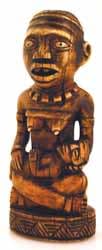Yombe Ivory Pfemba Sculpture, 19th Century CE - 20th Century CE
Ivory
2.5 x 6.25
PF.4258 (LSO)
This dynamic ivory figure is Pfemba “maternity” figure from the Yombe (Kongo) people of what was once Zaire. It is a traditional rendering of the genre, with a cross-legged woman...
This dynamic ivory figure is Pfemba “maternity” figure from the Yombe (Kongo) people of what was once Zaire. It is a traditional rendering of the genre, with a cross-legged woman seated in a hatched-design pedestal base, holding a child on her lap. The carving is highly detailed, with a decorated cap, a chain necklace, bands around the chest and arms, bracelets and anklets. The face is typically and finely rendered, with pin-prick pupils in oval eyes, a broad nose and an open mouth displaying two large teeth.
The Yombe are one of many groupos within the Kongo (or Bakongo) people, that live in the Democratic Republic of the Congo, Angola and the Congo. The kingdom absorbed European traditions and religion without notable bloodshed, and, more importantly, with much of their indigenous culture intact. Indigenous Kongo society was based around the kingship model, with extensive arrays of civil servants and court officials not unlike that of the Nigerian Kingdom of Benin. Owing to the large size of the area in which they live, this group is often unable to communicate and has to rely upon French/Portuguese or creoles based upon them.
Their religious beliefs are based around a reverence for the dead who are believed to be able to assist in the determination of future destinies. They are also believed to inhabit minkisi (singular nkisi), or charms, that can be appealed to for assistance in times of duress or uncertainty. The most notable pieces of Kongo sculpture are the Nkisi Nkondi nail fetishes which are insulted and “hurt” so that they will carry out the wishes of their tormentor. This is a maternity figure.
Maternity figures are not designed to be prayers incarnate, as they are with Asante Akua’ba dolls or similar; they are instead designed to portray what the Kongo people believe to be the ideal characteristics of womanhood – submission, deference, obedience and devotion – rather than just portray the beauty of maternity; in some cases the baby is actually absent. The quality of the carving makes it probable that the piece was made for, or commissioned/owned by a high-ranking member of Kongo society, in line with the evidently high status of the woman portrayed. The fact that the piece is made of ivory confirms this assertion.
This is an interesting and charming piece of African art.
The Yombe are one of many groupos within the Kongo (or Bakongo) people, that live in the Democratic Republic of the Congo, Angola and the Congo. The kingdom absorbed European traditions and religion without notable bloodshed, and, more importantly, with much of their indigenous culture intact. Indigenous Kongo society was based around the kingship model, with extensive arrays of civil servants and court officials not unlike that of the Nigerian Kingdom of Benin. Owing to the large size of the area in which they live, this group is often unable to communicate and has to rely upon French/Portuguese or creoles based upon them.
Their religious beliefs are based around a reverence for the dead who are believed to be able to assist in the determination of future destinies. They are also believed to inhabit minkisi (singular nkisi), or charms, that can be appealed to for assistance in times of duress or uncertainty. The most notable pieces of Kongo sculpture are the Nkisi Nkondi nail fetishes which are insulted and “hurt” so that they will carry out the wishes of their tormentor. This is a maternity figure.
Maternity figures are not designed to be prayers incarnate, as they are with Asante Akua’ba dolls or similar; they are instead designed to portray what the Kongo people believe to be the ideal characteristics of womanhood – submission, deference, obedience and devotion – rather than just portray the beauty of maternity; in some cases the baby is actually absent. The quality of the carving makes it probable that the piece was made for, or commissioned/owned by a high-ranking member of Kongo society, in line with the evidently high status of the woman portrayed. The fact that the piece is made of ivory confirms this assertion.
This is an interesting and charming piece of African art.
